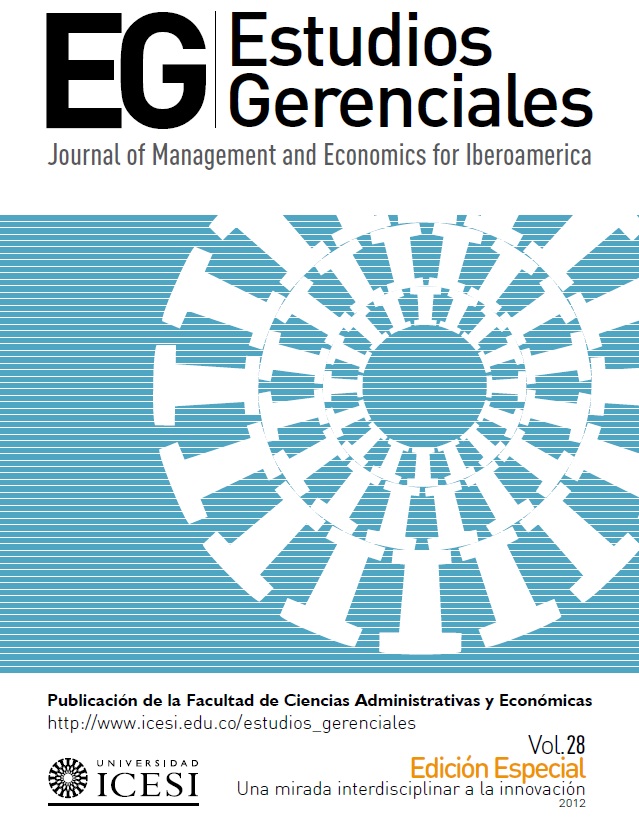La filial trampolín: una innovación organizativa en la internacionalización de la empresa europea en Latinoamérica
DOI:
https://doi.org/10.18046/j.estger.2012.1476Palavras-chave:
Empresa multinacional, proceso internacionalización, filiales, Latinoamérica, España.Resumo
Este artículo dota de contenido teórico a los conceptos de país trampolín y filial trampolín. Una realidad en las relaciones España-Latinoamérica que, pese a estar continuamente presente en la agenda política y diplomática, no ha sido analizada desde el punto de vista de la investigación en dirección de empresas. La filial trampolín se configura como una innovación organizativa que permite capitalizar las ventajas del país trampolín en la mejora de la eficiencia de las estrategias de internacionalización de la empresa europea en Latinoamérica.
Downloads
Referências
Barkema, H. & Vermeulen, F. (1998). International expansion through start-quo or acquisition: a learning perspective. Academy of Management Journal, 4(1), 7-26.
Bartlett, C.A. & Ghoshal, S. (1989). Managing Across Borders: The Transnational Solution. Boston, MA: Harvard Business School Press.
Birkinshaw, J., Bouquet, C. & Ambos, T. (2007). Managing executive attention in the Global Company. Sloan Management Review, 48(4), 39-45.
Björkman, I. (1996). Market entry and development in China. En J. Chil & L. Yuan (Eds.), Management issues in China: International enterprises. Londres: Routledge.
Chandler, A. (1962). Strategy and structure: chapters in the history of the industrial enterprise. Cambridge, MA: MIT Press.
Chislett, W. (2002). Spanish direct investment in Latin America: challenges and opportunities. Madrid: Real Instituto Elcano.
Eriksson, K., Johanson, A., Majkgard, A. & Sharma, D. (1997). Experiential Knowledge and Cost in the internationalization process. Journal of International Business Studies, 28(4), 807-825.
Forsgren, M. (2002). The concept of learning in the Uppsala Internationalization process model: a critical review. International Business Review, 11(3), 257-277.
Guillen, M.F. (2006). El auge de la empresa multinacional española. Madrid: Marcial Pons.
Gupta, A.K. & Govindarajan, V. (1991). Knowledge flows and the structure of control within multinational corporations. Academy of Management Review, 16(4), 768-792.
Hofstede, G. (1980). Culture's consequences: international differences in work related values. Londres: Sage.
Invest in Spain. (2012). Spain tour partner in Europe: Business Opportunities. Madrid: Instituto de Comercio Exterior.
Jarillo, J.C. & Martínez, J.I. (1990). Different roles for subsidiaries: the case of multinational corporations in Spain. Strategic Management Journal, 11(7), 501-512.
Johanson, J. & Mattsson, L.G. (1988). Internationalisation in Industrial Systems: A Network Approach. En N. Hood & J.E. Vahlne (Eds.), Strategies in Global Competition (pp. 198-211). New York, NY: Croom Helm.
Johanson, J. & Vahlne, J.E. (1977). The Internationalisation Process of the Firm- A model of Knowledge Development and Increasing Foreign Market Commitment. Journal of International Business Studies, 8(1), 23-32.
Johanson, J. & Wiedersheim-Paul, F. (1975). The Internationalisation process of the Firms: Four Swedish Case Studies. Journal of Management Studies, 12(3), 305-322.
Khanna, T., Palepu, K. & Sinha, J. (2005). Strategies that fit emerging markets. Harvard Business Review, 83(6), 63-76.
Kogut, B. & Singh, A. (1988). The effect of National Culture on the Choice of Entry Mode. Journal of International Business Studies, 19(3), 411-432.
Kostova, T. & Zaheer, S. (1999). Organizational Legitimacy under conditions of complexity: the case of the multinational enterprise. Academy of Management Review, 24(1), 64-81.
Monteiro, L.F., Arvidsson, N. & Birkinshaw, J. (2008). Knowledge Flows within Multinational Corporations: Explaining Subsidiary Isolation and Its Performance Implications. Organization Science, 19(1), 90-110.
Pla-Barber, J. (2001). The internalisation of foreign distribution and production activities: New empirical evidence from Spain. International Business Review, 10(4), 455-474.
Ronen, S. & Shenkar, O. (1985). Clustering countries on Attitudinal Dimensions. Academy of Management Journal, 10(3), 435-454.
Rugman, A. & Verbeke, A. (2001). Subsidiary- Specific Advantages in Multinational Enterprises. Strategic Management Journal, 22(3), 237-250.
Santiso, J. (2007). La internacionalización de las empresas españolas: hitos y retos. Información Comercial Española, 839, 89-102.
Scott, R. (1995). Institutions and Organizations. Thousand Oaks, CA: Sage.
Soler-Matutes, J. (2007). Triangulación Asia- España-América Latina. Documentos Cidob, 14.
Surlemont, B. (1998). A typology of centres within multinational corporations: an empirical investigation. En J. Birkinshaw & N. Hood (Eds.), Multinational corporate evolution and subsidiary development (pp. 162-188). Londres: Macmillan Press.
Downloads
Publicado
Edição
Seção
Licença
Os autores dos artigos serão responsáveis dos mesmos e, assim, não comprometam os princípios ou políticas da Universidade Icesi nem do Conselho Editorial da revista Estudios Gerenciales. Os autores autorizam e aceitam a transferência de todos os direitos para a revista Estudios Gerenciales para a publicão impressa ou eletrônica. Após a publicação do artigo, pode ser reproduzido sem a permissão do autor ou da revista, se mencionar o(s) autor(es), o ano, o título, o volume e o número e o intervalo de páginas da publicação, e Estudios Gerenciales como fonte (se abster de utilizar Revista Estudios Gerenciales).








